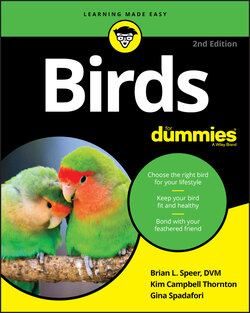Читать книгу Birds For Dummies - Gina Spadafori - Страница 91
Knowing what to look for in a cage
ОглавлениеWith so many cages on the market (or available secondhand), how can you be sure you’re buying one of high quality? Here are a few points to consider:
Design: You want a cage to be attractive, but even more important, it should be workable for your bird. Fortunately, if you shop well, you can find a cage that’s both well designed and good-looking.Look for features such as a bird-proof latch (especially if you have an escape artist like the Goffin’s cockatoo); dishes that are easy to move, remove, and clean; and a droppings tray that takes standard-size newspapers. Make sure that you can easily reach in and make contact with your bird, wherever she may be within the cage. In some emergencies, easy access is a critical concern. Make sure the food and water sources provide no “traps” to catch and injure toes, heads, wings, and so on. A mess catcher can be helpful, too — it looks like an inverted metal skirt around the base of the cage.The best position for the slide-out droppings tray at the bottom of the cage is under a grid so your bird can’t access it. High-impact, durable plastic or metal is a good choice for a droppings tray — no matter what the material, the tray should slide out smoothly and be easy to clean. Check your bird’s ability to move freely and comfortably in his cage without bumping into some obstruction. Too many perches, bowls, toys, or corners within the cage can lead to a loss of freedom of movement and a reduction of quality of life.Most people prefer vertical bars with the idea that they’re easier on long tail feathers. Horizontal bars are easier to climb for some birds, though. Either kind is fine, and some cages even mix them up, with vertical bars on some sides and horizontal on others.
Sturdiness: You’re going to have your bird and the cage for a long time, so you need to make sure the construction is solid. Check seams, welds, and places where wires and corners meet. Is everything all smooth and sturdy, with nothing for a bird to chip off and chew? Beware of chipping or flaking paint.
Convenience: A stand is great, especially with cages designed for smaller birds. You and your bird are likely to appreciate having the cage off the ground. You’ll appreciate the ease of access, and she’ll appreciate the visual perspective. Some stands come with shelves, handy for storing newspapers, food, and other supplies. Casters are a blessing, too, because you can easily move the cage and stand out from the wall to clean behind it. Placing a cage directly on the ground puts your bird in a vulnerable “low-altitude position” — one that can be stressful and psychologically undesirable for many birds. Even backyard chickens prefer to roost and rest on perches, up and off the ground. Ideally, a cage, perch, and stand combination that enables the bird to perch comfortably at about mid-chest height (yours, not his) is a great goal. Watch out, though: If you have medium to large parrots, and you allow them to get outside their cages and onto the tops —you may set the stage for a bit of a challenge to get your bird back in, particularly if he doesn’t want to, or sees no reason to do so. All the more reason for good training to be put in place! Too high can be as problematic in a different way as being too low. For more on behavior problems, as well as how to build and shape desirable behaviors, see Chapter 12.
Most cages come in one or two solid pieces — typically the cage part and the base, in the two-part variety — but you can buy some models that ship flat and require reassembly. These cages, called knockdowns, are held together with nuts and bolts, and a well-designed one has these fasteners in places where a busy bird is less likely to find them. Knockdowns are fine, but you have to remember to check the nuts and bolts from time to time to be sure they’re still tight. Parrots are really good at undoing your best efforts to keep nuts and bolts fastened.
